On September 13, 1598, Philip II of Spain died. He had reached the grand old age of 71 and his death was possibly cancer—although that wasn’t known back then. Despite the English people not wanting Philip II to become King of England and Ireland, it did happen due to his marriage to Mary I of England. However, many seem to forget about him after her death but there is much more to his story.

Death of Philip II of Spain: A Reason for Financial Problems in Spain?
How much do you know about Philip II of Spain? On September 13, 1596, he died after 52 days of suffering. Here is more about his life and story.
The Birth of Philip II of Spain
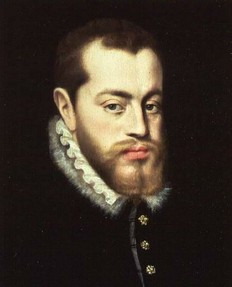 Philip was born on May 21, 1527 to Charles V, the Holy Roman Emperor, and Isabella of Portugal. For those who know their history, he was younger than his future wife, Mary Tudor, by 11 years!
Philip was born on May 21, 1527 to Charles V, the Holy Roman Emperor, and Isabella of Portugal. For those who know their history, he was younger than his future wife, Mary Tudor, by 11 years!
The young prince was raised to be the future King of Spain and he learned many languages, including Spanish, Latin and English. However, his father was always better and it was something that Philip possibly never got over. He was raised as a Spaniard, which meant a lot to Mary Tudor, but it made it difficult for him to be part of Europe—and England. Philip always felt as though he was Spanish and a foreigner in the Holy Roman Empire. It meant that he was overlooked when it came to the succession of the imperial throne.
At just 11 months old, Philip knew that he was hair to the Cortes of Castile crown. He was raised with this in mind by his mother, Isabella, and then Dona Lenor de Mascarenhas, one of her Portuguese ladies, upon her death in 1539. The two gained a deep attachment and Philip was also close to his two pages, Luis de Requesens and Ruy Gomez de Silva, and his two sisters, Juana and Maria. It was clear that family and close relationships meant very much to him.
An Early Marriage Proposition for Philip II of Spain
When Philip was in his teens, there was the prospect for marriage to Jeanne d’Albret, the Navarre heiress. She was also heiress to the majority of the south of France, which was an excellent prospect for the future King of Spain. For Charles V, it was an attempt at keeping hold of the Naverre throne, which had been acquired by Ferdinand II of Aragon—Charles’ grandfather and the father of Henry VIII’s first wife, Catherine of Aragon.
However, there was intrigue and opposition from much of Francis I’s French nobility. This led to the prospect ending in 1541.
Learn More About Philip II of Spain
 | 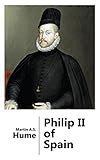 |  |
| Imprudent King: A New Life of Philip II Only $20.0 | Philip II of Spain Only $0.99 | World Without End: The Global Empire ... |
Dealing with the Debt of Charles V, the Holy Roman Emperor
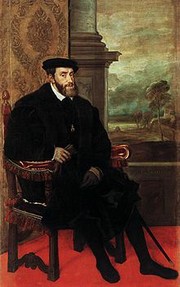 When Charles V died, Spain was in debt to the tune of 36 million ducats and 1 million annually. In some of the years between 1557 and 1596, Philip defaulted on loans due to the debt his father had left. Of course, the lenders had no way of forcing a king to repay the loans but it was the start of the economic problems for the country. These problems led to future kings having to default on loans over the next 65 years!
When Charles V died, Spain was in debt to the tune of 36 million ducats and 1 million annually. In some of the years between 1557 and 1596, Philip defaulted on loans due to the debt his father had left. Of course, the lenders had no way of forcing a king to repay the loans but it was the start of the economic problems for the country. These problems led to future kings having to default on loans over the next 65 years!
Philip had to make some serious decisions about the economics of his country. One of the first was to reduce state revenues for the expeditions overseas. However, there were other policies that he had to introduce that caused further burdens and led to the decline of the country.
A major problem for Philip was the fact that Spain had different assemblies for the kingdoms that were once separate, such as Castile and Aragon. These assemblies had their own laws and rights, causing problems for any ruler of the country. While the authority for each of the assemblies was administered by agents in the areas who were appointed by the crown, Philip felt the need to be involved in each detail, whether it was for war, finance and even the Spanish Inquisition.
Philip made it difficult for the different groups to work effectively as they played each other against one another. He also made poor decisions after the Valldolid fire in 1561, which meant that his court should have moved to Lisbon. Philip chose to remain in Spain and moved to Madrid, a Castilian stronghold. It meant that the bureaucracy couldn’t relax.
However, he did prove that he was a modern king for the day. He would direct state affairs without being at court, sometimes from his own quarters.
By 1596, Philip and the country was bankrupt. Philip continued military efforts until his death but it was constantly at a loss. It meant that gold and silver had to be shipped to the country—and more was shipped during the last 10 years of his life than the rest of his whole life!
Philip II Becomes King of England and Ireland
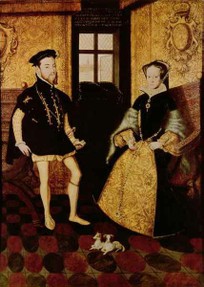 When Mary Tudor was 37, a marriage between herself and Philip was arranged. However, Philip wasn’t high enough in rank as Mary was already Queen of England for this. To ensure the marriage could happen, Charles V ceded his Naples crown and passed it onto Philip. At the same time, the Kingdom of Jerusalem was passed on.
When Mary Tudor was 37, a marriage between herself and Philip was arranged. However, Philip wasn’t high enough in rank as Mary was already Queen of England for this. To ensure the marriage could happen, Charles V ceded his Naples crown and passed it onto Philip. At the same time, the Kingdom of Jerusalem was passed on.
This arrangement worked and the two were married on July 25, 1554, at Winchester Catherdral. Philip had only met his bride, 11 years his senior, two days earlier. It wasn’t a marriage of love for the Spaniard; it was a political one. Philip likely knew that this wasn’t a marriage that England wanted. The issue for the people of England was that they had never had a successful queen regnant. The two before Mary—Empress Matilda and Lady Jane Grey—were controversial and poor.
The marriage agreement worked in Philip’s favour. He would have all the honours and titles of his wife for the duration of their marriage. All Acts of Parliament and other official documents had to be signed and dated by both and they had joint authority. Philip was King of England and Ireland and co-reigned the country with his wife. However, there was a slight downside for the war-loving family; England would not have to provide any military support for Charles V.
There was a problem with the title of King of Ireland. When Henry VIII was excommunicated, the title King of Ireland had not been created. That happened in 1542 and was not recognised by the Catholic monarchs around the world. Pope Paul IV made changes through a papal bull in 1555 so the title was recognised.
Due to the agreement, Philip lost his right to the thrones when Mary died in 1558. To make matter worse, the marriage had been childless. The throne passed to Mary’s half-sister, Elizabeth Tudor.
Philip didn’t want to lose his English connection though and sought a marriage with the new queen. Elizabeth took so long to answer that Philip moved on and started looking at an alliance with Valois. This marriage would have always caused problems, though. Elizabeth was a Protestant and Philip a Catholic. Philip wanted England to go back to the Catholic ways but it was clear that Elizabeth never wanted that.
Philip did keep peace with the country though. When Pope Pius V excommunicated Elizabeth I, Philip defended her. However, Elizabeth never returned the kindness. She worked with the Netherlands and threatened to attack the treasure ships belonging to the Spanish. When Elizabeth finally attacked one of the Spanish ports, Philip realised that a relationship would never happen. Upon the signing of the Treaty of Nonsuch between Elizabeth and the Netherland rebels, Philip signed the Treaty of Joinville with the Catholic League of France—he viewed the English signing to be war.
The Spanish Armada and War on England
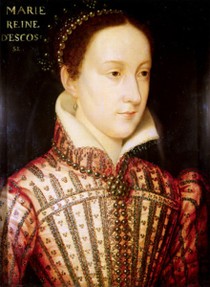 In 1587, Mary, Queen of Scots was executed. It was clear that England would never return to the Catholic country that it was. It was time to invade the country and he did that in 1588 with the Spanish Armada. In the end, the English defeated the Armada—but there was no chance of success in the first place.
In 1587, Mary, Queen of Scots was executed. It was clear that England would never return to the Catholic country that it was. It was time to invade the country and he did that in 1588 with the Spanish Armada. In the end, the English defeated the Armada—but there was no chance of success in the first place.
There were many delays and Philip II had poor communication with his commanders. Nature was also against them when a storm hit the English Channel right where the attack was going to take place—an area that was known for choppy waters and harsh currents. It was a poor battle plan and the English navy was just too good. Philip would see two more Armadas in the last two years of his life but they were not successful. However, it took the deaths of Philip and Elizabeth for the war between the two countries to really come to an end.
Read More About the Spanis Armada
 |  |  |
| Armada: The Spanish Enterprise and En... | The Spanish Armada: A History Only $11.99 | The Confident Hope of a Miracle: The ... |
The Death of Philip II of Spain
Philip became ill 52 days before his death. It was an agonising and difficult time for the monarch. He had severe gout, dropsy and a fever; although historians believe that it was cancer that he was suffering from.
He was in so much pain that even moving was impossible. He couldn’t be washed or go to the toilet properly. To care for him as much as possible, the mattress has a hole cut into it so all his bodily fluids would drip out of it. It was an undignified end to such a prominent and powerful man in history.
You might also like
Haddon Hall: An Elizabethan Love Story That Shocked SocietyWhen the heiress of Haddon Hall eloped with her lover, Elizabethan society he...
Elizabeth I Contracts Smallpox: How Her Illness Changed Her Ap...The portraits of Elizabeth I don't show her true appearance. When she was 29,...
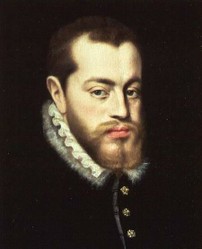





 Alternate History: What If Mary I Had a Child?on 01/26/2015
Alternate History: What If Mary I Had a Child?on 01/26/2015
 Francis II of France Dies: Mary, Queen of Scots Returns Homeon 12/05/2014
Francis II of France Dies: Mary, Queen of Scots Returns Homeon 12/05/2014
 Does Writedge Pay? Payment Proofon 12/03/2014
Does Writedge Pay? Payment Proofon 12/03/2014
 Alternate History: What If Lady Jane Grey Was Not Deposed?on 11/11/2014
Alternate History: What If Lady Jane Grey Was Not Deposed?on 11/11/2014
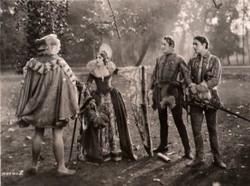
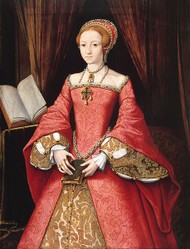
Comments
This is a very good article. But I believe that Philip II couldn't solve Spain's financial problems because they were started by The Alhambra Decree when Ferdinand II of Aragon expelled all Jews from Spain. It's actually ironic to see how countries who expel the Jews suffer financially for centuries to come.